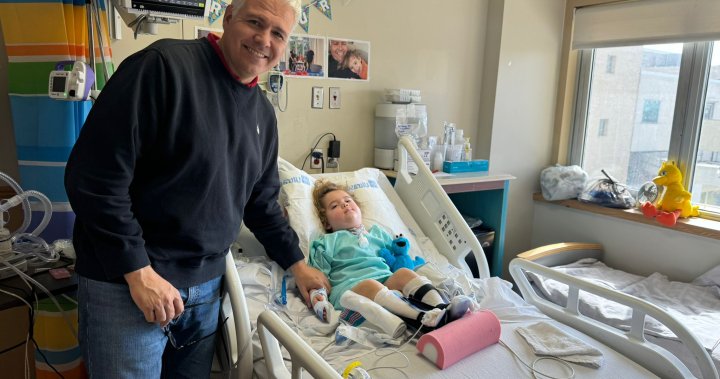In October 2024, two-and-a-half-year-old Arthur Tetrault experienced a near-drowning incident in a swimming pool. Following the accident, Arthur was rushed to the Lakeshore General Hospital and subsequently transferred to the Montreal Children’s Hospital. Arthur’s father, Nicolas Tetrault, became increasingly distressed with the prognosis offered by the medical team in Montreal, who believed Arthur had minimal chances of survival and would likely remain in a vegetative state. This bleak outlook spurred Tetrault to independently research alternative treatments, ultimately leading him to discover the work of Dr. Paul Harch, a Louisiana-based specialist in hyperbaric oxygen therapy. Dr. Harch has reported positive outcomes using this treatment for young brain injury victims, including those who have suffered near-drowning experiences.
Confronted with the medical team’s assessment and determined to explore every avenue for his son’s recovery, Tetrault requested that Arthur receive hyperbaric oxygen treatment and other oxygen-focused therapies. However, the Montreal Children’s Hospital declined his request, citing the lack of Health Canada approval for hyperbaric oxygen treatment in such cases. Tetrault claims the doctors dismissed his suggestions, characterizing them as unproven and ineffective. This clash of opinions highlighted a significant difference in perspective regarding the potential benefits of hyperbaric oxygen therapy, particularly in the context of drowning victims. While Tetrault clung to the hope offered by Dr. Harch’s work, the Montreal medical team remained steadfast in their opinion that such treatment was not evidence-based or appropriate for Arthur’s condition.
Dr. Pierre Marois, a child rehabilitation specialist, offered a nuanced perspective on the situation. Having consulted with both the Montreal Children’s Hospital and Dr. Harch, he expressed surprise at the early consideration of withdrawing life support for Arthur. Dr. Harch, on the other hand, suggested that the dismissal of alternative therapies like hyperbaric oxygen treatment is a common occurrence, particularly when proposed by parents. He argued that medical professionals tend to resist treatments unfamiliar to them or not taught in traditional medical curricula. This difference of opinion reflects a broader debate about the acceptance and implementation of novel medical treatments, especially those outside the mainstream.
Undeterred by the resistance he encountered in Montreal, Tetrault made arrangements to transfer Arthur to Ochsner Medical Center in New Orleans, where he believed his son would receive superior care and access to the desired hyperbaric oxygen therapy. This decision underscores a perceived contrast between the Canadian and American healthcare systems. Tetrault expressed a sense of being treated as a valued client in the US, compared to a perceived perception of being viewed as a financial burden within the Canadian system. This sentiment echoes a broader discussion about patient-centered care and the perceived differences in approach between the two countries’ healthcare models.
Legal expert Patrick Martin-Menard acknowledged that while the Quebec public healthcare system may lack a strong customer service orientation, the US system presents significant financial barriers. He cautioned against generalizations about either system, emphasizing that both have inherent strengths and weaknesses. While acknowledging potential shortcomings in the Canadian system, he questioned whether the American system, with its substantial financial hurdles, offered a genuinely superior alternative. This comparison highlights the complex trade-offs inherent in different healthcare models, particularly the balance between accessibility and the availability of potentially innovative treatments.
The Montreal Children’s Hospital (MCH) defended its decision, asserting that its actions were based on established best practices and the generally poor prognosis for children who experience prolonged cardiac arrest outside a hospital setting. They clarified that organ donation discussions are only initiated when death is imminent and never influence neuroprognosis or treatment decisions. The MCH also reiterated that hyperbaric oxygen treatment is not indicated for chronic oxygen deprivation brain injury after cardiac arrest and is not offered in Quebec. This statement reinforces the MCH’s adherence to evidence-based medicine and its position that hyperbaric oxygen treatment is not an accepted practice for Arthur’s condition within their protocols.
Dr. Christopher Labos, a cardiologist affiliated with McGill University, emphasized that hyperbaric oxygen therapy does have Health Canada-approved applications, but not for treating drowning victims. He affirmed that medical professionals have reasons for recommending against certain treatments based on the available evidence. He expressed skepticism about the efficacy of hyperbaric oxygen treatment in post-drowning cases, suggesting it lacks scientific support. This perspective underscores the importance of evidence-based decision-making in healthcare and highlights the potential risks of pursuing unproven treatments.
Despite the financial strain and uncertainty surrounding his son’s recovery, Tetrault remained hopeful and determined. He commenced Arthur’s hyperbaric oxygen therapy in New Orleans, prepared to bear the significant financial burden associated with the treatment. His social media updates documenting Arthur’s journey garnered widespread attention, fueling public interest in the case and the broader discussion about alternative treatments for brain injuries. While the long-term outcome for Arthur remains unknown, Tetrault expressed his commitment to advocating for access to treatments for drowning victims in the future. This case underscores the challenges parents face when navigating complex medical decisions and the lengths they will go to for their children’s well-being.

